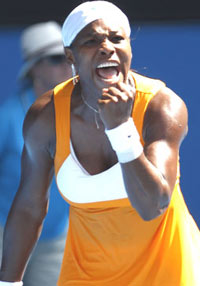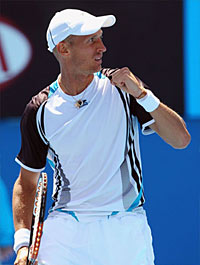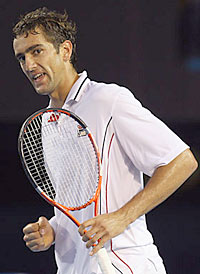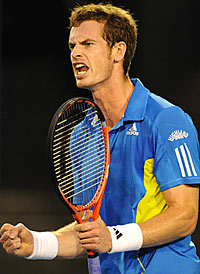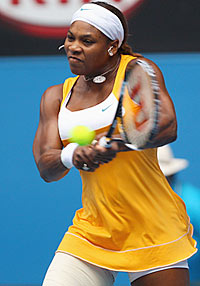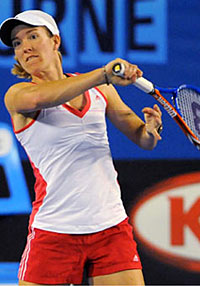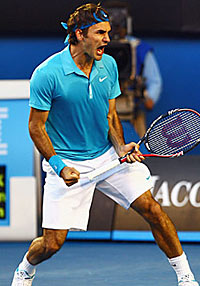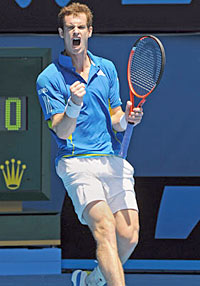|
TennisOne Lessons The Importance of Momentum in Tennis Paul Fein “Psychological momentum is the positive or negative change in cognition, affect, physiology, and behavior caused by an event or series of events that affects either the perceptions of the competitors or, perhaps, the quality of performance and the outcome of the competition.” – The Oxford Dictionary of Sports Science In tennis and basketball, more than in other sports, it is momentum that influences which player or team wins and loses. Basketball coaches predictably call time-outs to make substitutions and plot strategy to stop the negative momentum when opposing teams go on a scoring spree. However, tennis competitors don’t enjoy those luxuries. Play is stopped only for 90-second changeovers, a limited number of bathroom breaks, 10-minute breaks (for women) after the second set, and trainer breaks for injuries. Substitutions, of course, are prohibited. And players must rely on their own tactical wits, except when on-court coaching is allowed in team competitions and for women in non-Grand Slam tournaments. Faking injury or illness in pro tennis has become the new stalling gambit for breaking an opponent's momentum as well as getting a restful trainer break. Before Hawk-Eye and “player challenges” expeditiously resolved line call questions, provocateurs like John McEnroe, Jimmy Connors and Ilie Nastase not only badgered umpires and lines judges with time-consuming protests but also infuriated foes eager to resume their winning momentum. “The Big Mo” in tennis can switch within the blink of an eye and stun unsuspecting players and spectators. It can carry the athlete a long way, sometimes to ultimate victory. Or, it can, just as suddenly, be lost, so that one's opponent rides the wondrous waves just as swiftly and as far as he had moments earlier. Superstars capitalize ruthlessly on momentum. Serena Williams’ visceral intensity and Roger Federer’s almost preternatural calmness helped them escape defeat at the Australian Open by slamming the brakes on opponents’ powerful momentum and then accelerating their own “Big Mo.” How did they do it? And what lessons can we learn from them? Let’s find out. Serena Williams vs. Victoria Azarenka Serena arrived Down Under at her fighting weight and lost only 15 total games in her opening four matches. Equally impressive, the No. 1 seed and consensus favorite held serve 31 straight times, making her the only player – male or female – not to drop a service game en route to the quarterfinals.
Azarenka, a 20-year-old from Belarus, had Serena in trouble at the 2009 Aussie Open when she led 6-3, 2-4 before retiring due to dizziness and sickness. She avenged that by crushing an injured Serena 6-3, 6-1 in the Sony Ericsson Open final two months later. Serena then dispatched her 6-2, 6-3 on Wimbledon grass. Since the summer of 2005, Azarenka has resided in Scottsdale, Arizona, with the family of pro hockey standout Nicolai Khabibulin who has mentored her. “I talk to him about anything,” she says. ”Like if I need something, like my emotions or whatever, he always tells me what to do or how to handle the situations.“ That valuable advice helped calm and concentrate the sometimes-volatile Azarenka as she rose to No. 7. Fitter and more mature this year, Azarenka brought the requisite confidence and bold game plan to spring a major upset. Like a shorter version of Maria Sharapova, the attractive Eastern European blonde also boasts explosive groundstrokes, ear-splitting shrieks, and a ferocious competitiveness. Azarenka whacked back Serena’s powerful serves (up to 200 kph; 124 mph) almost as fast as they arrived, and she disdainfully blasted almost everything else to break shell-shocked Serena’s serve thrice to win the opening set 6-4. Two more service breaks put Serena, trailing 4-0 in the second set, on the ropes. “I can’t remember a time when Serena played this much defense in a match,” astute ESPN analyst Patrick McEnroe noted. When Serena broke back to cut the deficit to 4-2, McEnroe reminded viewers: “I’ve seen Serena come back so many times over the years. Never count her out!” In the first set, Serena's shots lacked conviction and her footwork looked a bit slow and awkward. But, in the second set, she would neutralize Azarenka's irresistible force, especially her booming backhands, by hitting harder and running faster. She had to because Azarenka performed at the same high level, except for a costly double-fault to lose serve to make it 4-all.
The momentum had switched because Serena had called on her memory bank of inspiring comebacks – she saved match points in the 2003 semifinals against Kim Clijsters and in the 2005 semifinals against Sharapova en route to Australian titles – and hit her way out of near-defeat. When the tiebreaker arrived, increasingly confident Serena found her A Game. Down 3-1, she reeled off six of the next seven points, highlighted by a service return winner, smash and ace. Once Serena broke Azarenka at love with a backhand service return winner for 2-1 and then belted three aces to hold serve at love for a 3-1 lead, she became the irresistible force. Increasingly, she pounded Azarenka’s vulnerable second serve that averaged only 135 kph (84 mph). Statistics told the third set story: Serena racked up 18 winners against only three unforced errors. What could Azarenka have done to reverse Serena’s seemingly unstoppable momentum? Not much during the 6-2 deciding set, because Serena at her killer instinct best is more formidable and intimidating than any other woman at her best. However, Azarenka, who was out-aced 17-1, can increase her first serve and second serve power and improve her foot speed. She can also become a more versatile, clever player, and thus more effective when her power game falters. To her credit, she kept her temper in check, aside from angrily smacking a ball into the corner of the court during the tiebreaker. Azarenka can also take heart that she won almost as many total points (105 to 102) as Serena and broke serve almost as often (6/13 to 5/13) in their 4-6, 7-6, 6-2 quarterfinal. She has beaten Serena before and can do it again if she performs better on pivotal points to both sustain her momentum and break Serena’s. Roger Federer vs. Nicolay Davydenko “It ain’t bragging if you can back it up,” boxing immortal Muhammad Ali famously said. He could. At the start of the Australian Open, usually reserved world No. 6 Nicolay Davydenko surprisingly crowed, “Now everyone’s scared of me. It’s an interesting feeling. Now I feel like I can beat everyone.” Did that smack talk smack of real confidence or just bravado? And could he back it up in best-of-five-set matches at a Grand Slam tournament – not just at tour events where he had recently knocked off both Federer and Rafael Nadal twice in a row?
In their four previous Grand Slam matches, the 28-year-old Russian had won only one set. This time Davydenko raced off to a 6-2 first set – exactly the terrific start that an underdog needs. His heavy, accurate and deep groundstrokes were punishing Federer’s vulnerable backhand and preventing his forehand from doing its usual heavy damage. Federer made a tactical mistake by rushing between points on his service games when he should have slowed down. But he rectified that by shrewdly taking a bathroom break (though this unduly permissive rule should be changed) after the first set to try to slow Davydenko’s momentum. When Davydenko stretched his lead to 3-1 in the second set, Darren Cahill, the topnotch ESPN analyst, said: “Federer is going to have to turn this match around with his forehand and his feet.” Fed trailed 15-40 on his serve before escaping two break points to hold serve. In his post-match press conference, Federer acknowledged he had to dig very deep to get out of this predicament. He also struck an optimistic note about how he had reversed the momentum. ”That's the beauty of best-of -five sets. I wasn't panicking, even though I maybe would have lost the second set had I lost another point there at that stage,“ Fed said. ”But I just relaxed and thought maybe if the sun [blinding him on his serve] goes and his level drops just a little bit, the whole thing might change for the better. It did. I couldn't believe the way it changed.“ Like Serena, The Mighty Fed could summon hope from a deep reservoir of confidence based on his then, 15 major titles, including three Aussie titles, and his 12-2 record against Davydenko. Unlike Azarenka, though, Davydenko became totally unglued. From that 6-3, 3-1, 15-40 nadir, Federer seized 47 of the next 58 points and 13 straight games, including a 6-0 third set, to lead 2-0 in the fourth. “I can’t remember a bigger turnaround,” Cahill commented. What happened? We know the Swiss maestro can perform magically and make even elite opponents seem like mere foils for his artistry. But, during this streak, Davydenko, who had struggled with his serve throughout the match, lost his nerve on his normally aggressive groundstrokes and compounded that by making unforced errors galore.
The collapse was so complete that noted coach Brad Gilbert, another ESPN analyst, remarked: “Davydenko is panicking and rushing, and his shot selection has become poor, as well as his body language. A lot of doubt has crept in.” Even though Davydenko had rebounded after losing the third and fourth sets against ninth-seeded Fernando Verdasco in the previous round, Cahill doubted the Russian could repeat a similar scenario against the steamrolling Federer: “I rarely see Davydenko get his game back after a bad start or spell.” Yet, the determined Davydenko did regroup in the fourth set and almost reversed the momentum yet another time. He belted a forehand to break Federer to level at 3-all and held serve easily to go ahead 4-3. Then, suddenly Federer was down love-40! And, in mini-momentum breaker, Fed won five straight points – thanks to five strong first serves – to escape. The fluctuations continued when Davydenko lost his serve on a double-fault, and Federer lost his serve, too, on a forced volley error to make it 5-5. Perhaps Davydenko had expended too much physical and emotional energy because though he staved off three break points in a marathon 16-point game, Federer finally won it and then served out the last game at love. “It’s the most ebbs and flows I’ve ever seen in a match,” commented Gilbert about the 2-6, 6-3, 6-0, 7-5 quarterfinal. Afterwards Federer talked about how Davydenko can “go through incredible spells for a half hour or an hour. You have to stick with him, If you don’t, he’s going to crush you.” Federer offered a second lesson about dealing with momentum in long matches. “In a best-of-five-sets match, it’s best to stay relaxed. It’s a test of mental and physical toughness. And I feel I’m superior in these two areas against Nicolay.” Federer also proved superior in what is often the most important statistic in close matches: break point conversions. The champion cashed in 8 of 14, while the contender only 5 of 19. Andy Murray vs. Marin Cilic
Seeded a misleading 14th in the talent-deep men’s game, Marin Cilic upset No. 4 Juan-Martin del Potro and No. 7 Andy Roddick in exciting five-setters. But the 21-year-old Croat played 18 hours and 8 minutes en route to the semis, his best result in a Slam event, compared to only 10 hours and 1 minute for Andy Murray. The 22-year-old Scotsman notched his best win in a major by ousting No. 2 Rafael Nadal who retired when losing 6-3, 7-6, 3-0, due to knee pain. Although Murray led their rivalry 3-1, Cilic dealt him an embarrassing 7-5, 6-2, 6-2 setback at the 2009 U.S. Open when Murray’s counter-punching style deteriorated into utter timidity. Murray should have learned a lesson from that debacle, but he was again passive and allowed the 6’6” Cilic to dictate baseline exchanges and grab the opening set 6-3. Murray was also losing the battle for position as he was hitting only about 30 percent of his groundstrokes from inside the baseline compared to about 50 percent for Cilic. One spectacular shot at the right time can change the entire course of a tennis match. Murray’s stroke of genius came on break point against Cilic at 2-all in the second set. After the speedy Murray sprinted forward to reach a ball near the net, he lunged for a volley that Cilic countered with a lob volley that landed just inside the baseline. Murray raced back and cracked a dazzling forehand passing shot that Cilic, who mistakenly took two steps backward to cover a lob, mishandled. Murray roared, and the crowd roared back. Gilbert, Murray’s former coach, says Britain’s best male player since Fred Perry in the 1930s, performs best when he’s extroverted, and this amazing shot brought him out of his passive shell, both emotionally and tactically. “It was really important because I don’t want to say the match was slipping away from me, but the momentum was definitely with him,” Murray said afterward. “That shot made a huge difference, I felt more confident and started going for my shots, and really managed to turn it around.”
While the circus shot pumped up Murray, it deflated Cilic. Known for his calmness and tactical acumen – tour veterans consult him for pre-match advice – Cilic had no answers thereafter. Murray played intelligently with a controlled aggression that kept the tiring Cilic on the run and his own unforced errors down (only 29 vs. Cilic’s 54) to record a 3-6, 6-4, 6-4, 6-2 triumph. Serena Williams vs. Justine Henin This eagerly anticipated duel pitted the reigning queen against the former queen who shockingly abdicated her throne while ranked No. 1 in May 2008. In her last full year, Henin had beaten Serena in quarterfinals at Roland Garros, Wimbledon, and Flushing Meadows. Could she now emulate compatriot Kim Clijsters who stunned everyone by capturing the 2009 U.S. Open in only her third tournament back after a 30-month retirement? Could she win the Australian Open in only the second tournament of her equally intriguing comeback after a 20-month retirement?
Just the opportunity to pull off such an amazing feat exhilarated the undersized (5’5 ¾”, 126-pound) Belgian. “We’ve never played in a Grand Slam final in the past. It’s my first Grand Slam since I’m back, and we’re already there. So it’s more than a dream,” confided Henin. “I mean, I’m so happy to play against her because if I want to win another Grand Slam, I’ll have to beat the best player of the world. And that’s just the biggest challenge I could get.” Dedicated to perform even better than before her brief retirement, the already versatile Henin shortened her forehand backswing, studied superstar quarterback Brett Favre’s throwing motion to improve her serve, and tried to approach net more than ever, sometimes by attacking second serves. Did Serena dominate in 2009 because Henin and Clijsters were missing (aside from Clijsters at the U.S. Open) and Maria Sharapova played way below peak form because of a serious shoulder injury? With Clijsters and Sharapova eliminated in early-round Oz Open upsets, Henin would provide the first answer in the new decade. Sometimes, one weapon can create and break momentum. In this riveting match, momentum came from Serena’s powerful and accurate serve which produced 12 aces and 18 more points when Henin failed to return it. Quite a few times, though, Henin let Serena off the hook by erring with recklessly aggressive returns against Serena’s high-bouncing kick second serve. Martina Navratilova calls Henin “the female Federer,” and the supremely talented Belgian should emulate Federer’s consistent slice backhand service returns, particularly on precious deuce, ad-in and ad-out points. There were no huge momentum changes in the final, which was close until 2-2 in the deciding set. Then Serena pulled away, breaking serve twice and taking 16 of the last 22 points. However, Henin did break Serena’s last two service games in the second set and won the opening game of the third set at love. Serena saved two break points in the next game and took the wind out of Henin’s sails with two aces and three more unreturnable serves to stay even at 1-all. Aside from an errant service toss (too low and too far to the right), Henin played as skillfully as before her retirement, and perhaps even better. She also handled the pressure quite well so early in her career comeback – until the final. Then Henin’s lack of recent experience playing big points in a major final showed. She converted only 5 of 16 break points, and just 1 of 7 in the crucial first set. “I get up for the big ones,” explained Serena about why she plays her best tennis at Grand Slam events, and especially in finals. Sounding much like Serena, Henin confided, “Winning big tournaments – that’s my motivation.” The next big tournament is the French Open, which Henin has captured four times, while covetous Serena owns just one French title. “Now I have to figure out a way to win me some more French Opens,” quipped Serena after she tied Billie Jean King, her idol, by winning her 12th major crown Down Under. For Henin, the quest to win Wimbledon, the only major title she doesn’t own, loomed large in her decision to come back. “It is a dream of mine,” she says. “I want to work to get it.” The Rivalry is back! Roger Federer vs. Andy Murray
“If that match doesn’t live up to the hype, I’m the queen of Sheba,” all-time great Navratilova quipped before the final. The problem was, it takes two to make a classic final, and while Federer thrives on pressure, Murray is all too often overwhelmed by it. Murray talked about being more mature and prepared than when The Mighty Fed crushed him 6-2, 7-5, 6-2 in the 2008 U.S. Open final. But, in many ways, he really wasn’t, even though he owned a 6-4 career edge over TMF. Conventional wisdom says that counter-puncher Murray merely has to attack opportunistically while returning serve well and frustrating opponents with change-of-pace shots and superb defense. The problem is, Murray lacks the courage to attack opportunistically – particularly on the most important points in the most important matches. That fear, however, is quite rational and justified. That’s because while The Great Ones have great shots, usually the serve and forehand, Murray has no great shots. Yes, in some matches, his service return is excellent, but hardly in the class of Andre Agassi. Contrast that with Federer who owns the best forehand in tennis history and a brilliant serve, much like Serena’s, that frequently fires aces as well as forces errors and weak returns, especially on break points, game points, and set points. Federer wound up with 46 winners (including 19 forehand and 11 aces) compared to Murray’s 29, and won 31 of 43 points (72%) on net approaches versus 14 of 23 (61%) for Murray.
“Murray isn’t comfortable at pulling the trigger, going on the offensive, early in the point,” rightly noted McEnroe. That shortcoming proved fatal for the hesitant Murray in the 6-3, 6-4, 7-6 final, which had little momentum aside from Federer’s domination for two sets. Murray did pick it up a notch in the third set when he broke serve with a forehand volley winner during a rare volley duel to lead 4-2. But he failed to convert five set points in the 13-11 tiebreaker. The first miscue came on a forehand approach that Federer, in a similar situation, would have punished; the second from a makeable backhand volley that landed in the alley; and the last on a service return error. Just as disappointing in the tiebreaker, Murray committed five unforced errors and made only four of his 12 first serves, hitting several into the middle of the net because his contact point was much too low. Just as he didn’t sprint forward to crack mid-court forehands on the rise, he didn’t reach up high to belt serves. McEnroe summed it up perfectly when he advised: “When you get to a championship final, you need great offense.” Your comments are welcome. Let us know what you think about Paul Fein's article by emailing us here at TennisOne.
Paul Fein Paul Fein, a USPTA teaching pro and former top 10-ranked New England men’s open player, has won more than 25 writing awards. His 2002 book, Tennis Confidential: Today’s Greatest Players, Matches, and Controversies, published by Brassey’s, Inc., was listed No. 1 among tennis books by Amazon.com and BN.com. Information about the book and how to order it can be found at www.tennisconfidential.com. His second book, You Can Quote Me on That: Greatest Tennis Quips, Insights, and Zingers, was published by Potomac Books, Inc. (formerly Brassey’s, Inc.) in 2005 and was listed No. 1 among tennis books by Amazon.com and BN.com. For more information, visit www.tennisquotes.com. His third book, Tennis Confidential II: More of Today’s Greatest Players, Matches, and Controversies, was published April 28, 2008 and was featured on the home page of Amazon.com. |


